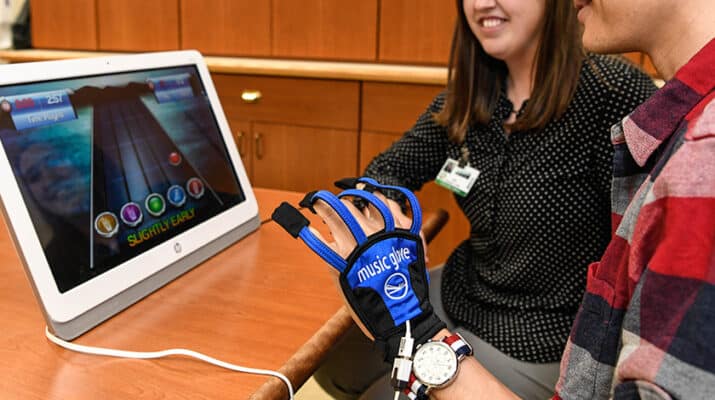By Jana Eisenberg
The field of occupational therapy (OT) is one of the helping professions — the populations of people it has the potential to positively affect spans the life cycle, from newborns, to children, adolescent and young adults, to people who are sick or aging.
It’s a still-evolving field, yet one that, unless you or a loved one has experienced it, might not be familiar.
To clarify a common assumption, the “occupation” in “occupational therapy” doesn’t necessarily mean “work-related” — it includes anything that occupies a person in the course of daily life.
That could mean relatively simple things like brushing your teeth and bathing or more complex activities like getting in and out of a car, going to the dentist or, yes, being able to sit at a desk and work.
And unlike physical therapy (PT), which mostly focuses on movement and strengthening, OT focuses on the intersection of movement and cognitive skills, addressing problem-solving, sensory capability and environment in the context of a person’s life.
OTs can work in hospitals, clinics, schools, rehab facilities, private practice, nursing homes, and home health care agencies; the therapy is often provided in conjunction with other treatments, like physical, speech or audiology therapies.
Jim Lenker, an occupational therapist and an associate professor in the University at Buffalo Department of Rehabilitation Science, and program director for the Advanced Graduate Certificate Program in Assistive & Rehabilitation Technology, says that the basic goals of OT are to help people engage in life’s meaningful activities.
In addition to anatomy, neurobiology and kinesiology, OT training includes things like communication, psychology and human behavior.
“One of OT’s premises is to help people of any age to gain a stronger sense of identity and agency, after some disruption or erosion. OTs have a broad background; we also are trained to consider the patient’s goals,” said Lenker. “For family and caregivers, like people who have a child with a disability, or a relative who’s had an injury or illness, OT treatment sessions focus on purposeful activities, and also can help the caregivers to support their loved one.”
Erin McBundy is an occupational therapist in the Erie County Medical Center (ECMC) Outpatient Rehabilitation Department. She provides rehabilitation therapy for people who have neurological or physical impairments such as stroke or traumatic brain injury (TBI).
“We work with patients to find compensatory strategies to help them live at home, either independently or with caregivers — as safely as possible,” she said. “For example, I had a patient whose arm was affected by a stroke. She was excited to become a grandmother, but worried that she would not be able to hold the baby or take care of him. We used constraint-induced therapy which constrained her stronger arm, forcing use of her weaker arm. Weights were used that approximated the baby’s weight, and created adaptive strategies to independently dress him.”
“In many contexts, we’re trying to anticipate what needs and goals people will have,” said Lenker. “We work where we are recognized as having a legitimate contribution, helping to reduce risk and increase efficiency—whether it’s parents and babies learning to play, or assisting someone to be able to live independently for longer.”
A Career in OT Is Rewarding in Many Ways
UB assistant professor Jim Lenker points out that occupational therapy offers great opportunities for variety, working with different age groups and settings, like schools, hospitals, community-based program, or in mental health. And, he adds, there are plenty of good-paying jobs available—something for anyone, and especially middle-, high-school and undergraduate college students to consider.
“Like other areas of health care, including nursing, PT, and speech, there’s a wide range of geographic areas with acute needs; rural, suburban and urban,” he said. “The national median salary is around $75,000–78,000.”

The commitment to become a licensed OT requires a master’s degree, and the field offers options, also similar to a nursing career. “Earning a master’s, especially at a state college, is less expensive than medical school,” said Lenker. “There are also many programs that offer an OT assistant program, which can be a great career in itself, or a stepping-stone to becoming a licensed OT.”
He adds that while the profession has traditionally been made up of white female practitioners, greater diversity benefits all. “Patients, consumers, people in the public want to see a workforce that looks like them. Occupational therapists work on things that are generally private, like doing makeup, hair, dressing, bathing, on up to being able to get around in public with transportation, working and succeeding in school,” he said. “People usually feel comfortable working with those who can appreciate their lives and where they are.”

